The Port Royal Earthquake: John Darlington (1692)
John Darlington, author of Amongst the Ruins
‘I saw the earth open and swallow a multitude of people; and the sea mounting in upon us over the fortification,’ wrote Rev Edmund Heath a survivor of an earthquake in 1692 which destroyed Port Royal, Jamaica.
Captured by the English in 1655, Port Royal grew to be the principal Caribbean base for piracy, both official and unofficial, earning a reputation for high-spending, entertainment, drinking and debauchery – the ‘richest and wickedest city in the New World.’
*** [About our format] ***
As the earthquake struck on the morning of 7 June, Port Royal was home to around 6,500 people. Two thirds of the town sunk immediately into the sea as the sand liquefied, ships capsized and one was lifted over rooftops by the subsequent tsunami. Thousands more died in the following months, an eyewitness wrote that after, ‘… the Earthquake was a general Sickness, from the noisome Vapours belched forth, which swept away above 3000 Persons.’ The town never recovered, today Port Royal is a small fishing village, but the ruined remains of its heyday survive under the sea.
Port Royal earthquake 1692 by Jan Luyken and Pieter van der Aa (Wiki Commons)
Our guide on this dangerous journey back in time is the celebrated archaeologist John Darlington whose ‘obsession with ruinous and abandoned places’ began as a baby being pushed around the ruins of Leptis Magna in his pram. He currently works for the World Monuments Fund, and his new book Amongst The Ruins, Why Civilisations Collapse and Communities Disappear is published today by Yale University Press.
In it, he tells the stories of lost places as diverse as ancient Assyria and twentieth century St Kilda, grouping them around five themes, before offering some ideas for how this kind of destruction can be avoided in the future.
***
Yale University Press is offering Travels Through Time listeners a special 20% discount on our guest John Darlington's new book, Amongst the Ruins: Why Civilizations Collapse and Communities Disappear.
To buy John's book for just £20 with free P&P for UK orders only, go to the Yale University Press London website www.yalebooks.co.uk, search for the book and use discount code RUINS when prompted at the checkout.
This offer is valid from 11 April until 30 June 2023 and as mentioned is for UK orders only.
*** Listen to the Podcast ***
Show Notes
Scene One: 6 June 1692. Merchants, slaves, pirates and priests throng the heady streets of Port Royal, where there is one alehouse for every ten people. Huge ships arrive leaden with luxuries, docking in the deep-water harbour of the town, which is built on a fragile series of coral islands.
Scene Two: 11.40am, 7 June 1692. The Reverend Emmanuel Heath sits down with his friend John White, acting Governor of Jamaica, to enjoy a glass of wormwood wine. An earthquake strikes the city followed by a tsunami, sucking entire streets into the liquified sand, throwing ships over the collapsing buildings and ejecting corpses from graves.
Scene Three: 8 June 1692. The survivors survey the hellish remains of their city, most of which has disappeared under the sea or lies in ruins. A series of aftershocks cause more destruction and death, meanwhile diseases like Cholera begin to take hold, killing thousands more in the days to come.
Memento: A French pocket watch excavated from the under-sea ruins of the city, stopped at 11.40am on June 7th, the moment the earthquake struck.
People/Social
Presenter: Violet Moller
Guest: John Darlington
Production: Maria Nolan
Podcast partner: Yale University Press
Theme music: ‘Love Token’ from the album ‘This Is Us’ By Slava and Leonard Grigoryan
Follow us on Twitter: @tttpodcast_
See where 1692 fits on our Timeline
About John Darlington
John Darlington is an archaeologist and Executive Director of World Monuments Fund Britain. He is the author of Fake Heritage: Why We Rebuild Monuments and Amongst the Ruins: Why Civilizations Collapse and Communities Disappear.
This later seascape by Samuel Scott, depicting a sea battle off Havana, hints at the old views that would have been seen from Port Royal, half a century before.
(All images above: (c) Donny L. Hamilton, Nautical Archaeology Program, Texas A&M University)
Listen on YouTube
Complementary episodes
Skara Brae: Neil Oliver (2,500 bc)
In this beautifully-described episode Neil Oliver takes us back to the third millennium BC to see Skara Brae as it lived and to ponder why it died.
Ancient Egypt and Tutankhamun: Garry J. Shaw (c.1335 bc)
In this episode we are joined by the Egyptologist Garry J. Shaw who takes us back to the age of Tutankhamun to find out more about this figure who has come to represent so much.
The City at the Hub of the World: Michael Pye (1549)
This week’s destination has been called, ‘the most consistently cool city on earth,’ by the Lonely Planet Guide and there is no doubt that, in the mid sixteenth century at least, Antwerp was top of everyone’s list. Michael Pye tells us why.













